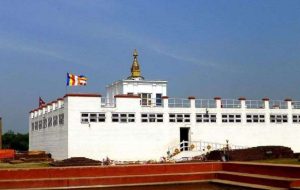
This column discusses the relationship between technology and the Dharma. Not only do these two topics have much in common, there is also great synergy between the two at many levels, as discussed at length in earlier articles.
Teaching, learning, and practicing the Dharma nowadays takes place mostly through the mediation of information technology in one form or another, especially so during the pandemic. Empowerments, teachings, practices, exchanges, and donations, as well as the publication of texts, videos, and sacred images are all happening online.
Cyberspace is now so filled with the Dharma that teachings, talks, practices, prayers, and chanting often take place back to back, one after another, without the usual breaks and interruptions found in in-person environments. We are now forced to practice in quarantine, and being segregated at home with access to multiple teachings and resources is resulting in more intense Dharma sessions than usual for many of us.
This is a very powerful moment for the Dharma, and the sangha has adapted quickly. However reluctant many rinpoches may initially have been to disseminate their precious gifts through modern technology, they now may have to resort to it—even if only sparingly.
Many eminent lamas—starting with His Holiness the Dalai Lama and including many rigorously ascetic practitioners such as Garchen Rinpoche—have started imparting teachings and giving transmissions, empowerments, and carrying out full pujas and retreats online without hesitation. This is because, in their wisdom and compassion, they see the vast potential of technology to benefit sentient beings.
After all, cyberspace is nothing but space itself. Like the mind, it is better filled with virtue than with vice. Strategically positioning cameras and microphones, and sometimes with live translators, teachers deliver messages of spiritual liberation to our eyes and ears. This surge of technologically mediated Dharma brings great convenience: we no longer have to travel great distances to connect with the most eminent teachings. We can now listen in, chant along, and unite in practice. With a little set-up and exercise of concentration, it is possible to visualize oneself in the same room as them.
This article brings up the topic of the responsible use of technology, especially for sanghas. Many resources and initiatives exist that target younger generations, students, public administrators, and senior citizens. This article is especially aimed at sanghas. When it comes to sanghas, we assume that our data and images are handled safely, but often there is no information about how this is done. As organizations and participation grow online, the responsible use of technology should be kept in mind.
Many rinpoches, endowed with great wisdom and skills, are embracing technology as a matter of course, but do not necessarily understand even the slightest thing about it really—other than perhaps whether or not it works. Yet this technology carries their faces and names, the precious wisdom of entire lineages, and the names and contact details of the practitioners who sign in, all out there on public display.
Community members worldwide eagerly sign up to mailing lists, newsletters, and online services to be notified and summoned. Their names and emails are in the system, and perhaps even photographs and other information as well.
This data may be vulnerable to misuse. After all, system administrators are human. Further, if an online sangha database is hacked, will we ever know? Who is to be held responsible?
Mindful technology reminders
This topic of good IT practices is vast. It cannot be exhausted in a single article, but it is worth bringing up a few key points and to advise the sangha to make a note of them:
1) Our data is in the hands of systems administrators, who are usually mere humans and often are volunteers bearing no legal status nor real responsibility. Dharma communities have tight budgets and often use donated resources. Neither the administrators nor the respective leaders can be held fully responsible for everything that goes wrong, after all, they are only trying to help and keep us in the virtual Dharma loop.
As a start, users should be responsible with the data they provide, and request that system administrators provide information about where and how their data is held and what measures are in place to protect it.
2) There are many opinionated systems administrators. The bigger the sangha and the better known the rinpoche or the community they serve, the more likely it is that the systems administrators are going to have stronger convictions and power. Nobody can judge or even really know what a system administrator does, because only they have that level of expertise, the passwords, and the backups. The only way to balance the power, wisdom, and conviction of individual system administrators is with strong governance, and that means management, procedure, and bureaucracies. And who wants that? But admittedly, few of the people sitting on the organizational committees of Dharma communities will be able to have meaningful conversations with system administrators, because they speak a language of their own and invoke arguments outside the sphere of wisdom of most sangha members. It is good practice to have a pool of experts and system administrators and to ensure that decisions are always openly discussed and, above all, fully documented, justified, and explained in plain language to the rest of the sangha. It is also good practice to have ongoing feedback loops from participants and users of the resources about their experiences, concerns, and priorities.
3) It does not matter if you are a khenpo, a rinpoche, a realized master, a practitioner, or a user; keep up with some of the developments in technology. Every good rule that applies to most schools and public administration around the world most likely also applies to your sangha.
4) Most importantly, be aware that there are laws coming up in relation to how and where personal data is stored. This may seem trivial, but as nobody escapes the laws of karma, nobody escapes the laws of data infringement either.
5) The EU and the UK have implemented General Data Protection Regulation (GDPR), that more or less requires website administrators to ensure the data that people enter to obtain a service is secured according to certain standards. But this may not always be straightforward. GDPR means that 28 European countries now have strict laws and can impose heavy fines should a data breach happen.* Several US states have also passed their own data-related laws.** For example, the California Consumer Privacy Act (CCPA) gives residents of California the right to know exactly what personal data is being collected and how it is being used, as well as the opportunity to say no to the sale of their personal data to suitably protect themselves.***
Websites must declare where data about users is held, especially for registered users. They also must say who is responsible for data management and if there are any possible breaches. At a minimum, users should know according to which legislation their data (their name and email address) is being protected, who is in charge, and who they can get in touch with, as well as how to change/update the data and who to contact in case of concerns.
In sum, as technology is now part of the Dharma and the Dharma is part of technology, everyone should raise their level of awareness about how data, including photographs taken during public events, is used and managed.
After all, the law of karma may manifest as a hefty fine in the case of non-compliance. To receive updates on this topic use this form.
* What to do in a Data Breach (Thales Group)
** State Laws Related to Internet Privacy (National Conference of State Legislatures)
*** California Consumer Privacy Act (CCPA) Compliance (Thales Group)
See more
Information Technology and Moral Values (Stanford Encyclopedia of Philosophy)












